
Meitei, officially known as Manipuri, is a Tibeto-Burman language of northeast India. It is the official language and the lingua franca of Manipur, as well as one of the 22 official languages of the Indian Republic, included in the 8th Schedule to the Indian Constitution. It is one of the advanced literary languages, recognised by Sahitya Akademi, India's National Academy of Letters. It serves as one of the recognised educational and literary languages in Assam and Tripura. Native to the Meitei people, it has around 3 million total speakers, and is used as L1 by around 1.8 million people, predominantly in the state of Manipur, and as L2 by different ethnic groups, in different parts of India, Myanmar and Bangladesh. It was used as a court language in the historic Manipur Kingdom, in accordance to the Manipur State Constitution Act 1947.
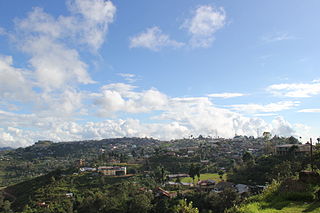
Ukhrul, also known as Hunphun, is a town in the state of Manipur, India. Ukhrul is the home of the Tangkhul Nagas. It is the administrative headquarter of the Ukhrul district. There are also four sub-divisions in the district for administering the villages in and around it. The villages, however, are governed by the 'village heads'. It is also famous for the Shirui Lily.
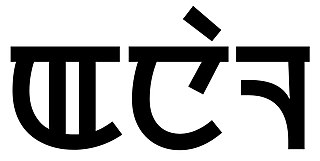
Anāl, also known as Namfau after the two principal villages it is spoken in, is a Northern Kukish language, part of the Sino-Tibetan language family, spoken by the Anal people in India and a dwindling number in Burma. It had 13,900 speakers in India according to the 2001 census, and 50 in Burma in 2010. The speakers of this language use Meitei language as their second language (L2) according to the Ethnologue.

Bishnupur district or Bishenpur district, is a district of Manipur state in northeastern India.

Senapati, is one of the 16 districts of the Indian state of Manipur. The present Senapati district was formed in December 2016, after spawning off the Sadar Hills region in the south into a separate Kangpokpi district. The district headquarter is located in the municipality of Tahamzam.

Ukhrul district is an administrative district of the state of Manipur in India with its headquarters at Ukhrul. The Ukhrul district has a long history dating back to the 1920s when it was created as the North-East Hill Sub-Division of the then princely state of Manipur. In 2016, the Kamjong subdivision of the Ukhrul district was spun out as a separate district, leading to the present configuration of the Ukhrul district.

The Tangkhul people, also known as the Tangkhul , are a Tibeto-Burmese ethnic group living in the Indo–Mayanmar border area, occupying the Ukhrul district and Kamjong district in the Northeast Indian state of Manipur, and in parts of neighbouring Myanmar. Despite this international border, many Tangkhul have continued to regard themselves as "one nation". The name "Tangkhul" is originated from the Meitei language words, "Tang" meaning "scarce" and "Khul" meaning "village" respectively. According to another theory of origin, the term "Tangkhul" is derived from "Thankhul", meaning "Than village" in Meitei language.
The Tangkhulic and Tangkhul languages are a group of Sino-Tibetan languages spoken mostly in northeastern Manipur, India. Conventionally classified as "Naga," they are not clearly related to other Naga languages, and are conservatively classified as an independent Tangkhul–Maring branch of Tibeto-Burman, pending further research.

Mao, also known as Sopvoma, is a Sino-Tibetan language of the Angami–Pochuri linguistic sub-branch. It is spoken primarily in Senapati district, northwestern Manipur and in Nagaland, India. It is similar to Angami. The speakers of this language use Meitei language as their second language (L2) according to the Ethnologue.

The Kharam people, also known as the Kharam Naga, are a Tibeto-Burmese ethnic group inhabiting the Northeast Indian state of Manipur. They are recognised as a Scheduled Tribe (STs) by India. They use Meitei language as their second language (L2) according to the Ethnologue.

Tarao, Taraotrong or Tarau is an unclassified Tibeto-Burman language of India. It is marginally (70%) intelligible with Chothe. The speakers of this language use Meitei language as their second language (L2) according to the Ethnologue.

Phalee also called as Phadang is a village located west of Ukhrul in Ukhrul district, Manipur state in India. It lies in the Indo-Burma Biodiversity Hot-Spot Region of the world wherein the flora and fauna diversity are very rich.
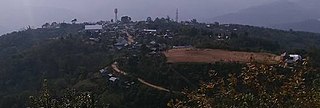
Phungcham is a village located north of Ukhrul in Ukhrul district, Manipur state, India. The village is approximately 28 kilometers from Ukhrul and is connected by inter village road constructed under PMGSY. Phungcham is flanked by Longpi and Lunghar in the east, Peh in the north, Ukhrul and Halang in the south and Talui in the west.
Phungyar is a small town located south of Kamjong in Kamjong district, Manipur state, India. It is also the name of a sub division of the district. The town is about 50 kilometers from Ukhrul and is partially connected by National Highway 150 that connects Imphal and Kohima via Ukhrul and Jessami. The town is flanked by Khambi in the south, Loushing in the north and alang in the west. Locally, the inhabitants speak common tangkhul language and native village dialect which belongs to the Tibeto-Burman language family.
Kamjong/Chassad is the headquarter of Kamjong district, Manipur state, India. The village is about 120 kilometers from Imphal and is connected by Ukhrul-Kamjong State highway. This District headquarter is flanked by Langli in the north, Bungpa in the south, the Phange in the east and Dangthi in the west.
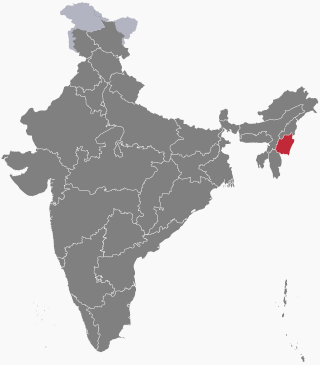
The following outline is provided as an overview of and topical guide to Manipur:
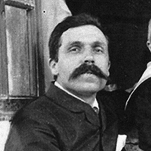
William Pettigrew was a British Christian missionary who went to India in 1890, eventually brought western education in Manipur and introducing Jesus Christ to the Tangkhul Naga tribe, inhabiting Ukhrul district and he became the main catalyst for the surge in current christian population in Manipur.

Kamjong District is one of the 16 districts of Manipur, India. It was created in 2016 from the Ukhrul district, prior to which it was a subdivision of the latter.
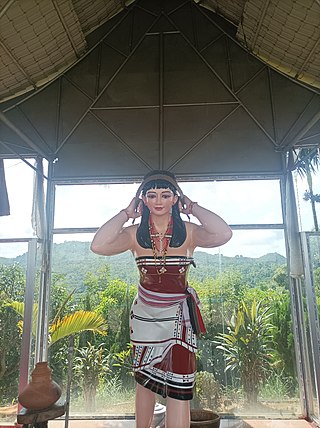
Haoreima or Haoleima is a goddess of tragic love and separation in Meitei mythology and religion of Ancient Kangleipak. According to some legends, she was a woman from the hills, who was killed while arranging to meet her lover, and turned into a tortured spirit. She is regarded as an incarnation of Goddess Panthoibi. She is also identified with goddess Nongthang Leima.

















